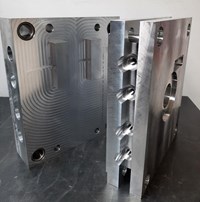
The future of automation is in making robotics accessible and valuable in all manufacturing settings. Source (All images) | GrayMatter Robotics
Molds and tooling come in all shapes and sizes, each requiring different levels of precision, but the finishing touches often impact the product's final quality and appearance. However, these manual tasks can be time-consuming, labor-intensive and prone to inconsistency.
That's where an AI-driven robotic solution developed to automate mold polishing — from sanding to buffing — may help change the overall moldmaking process.
Blending Brains and Brawn
The technology combines advanced robotics with sophisticated artificial intelligence to tackle the complexities of mold finishing. The system uses AI and machine learning to scan parts, generate robot motions and then incorporate the operator's expertise to fine-tune the process.
This adaptive approach is key to handling the diverse geometries and materials found in mold manufacturing. “We don’t differentiate between Class A, B or C surfaces. The system will scan the part, identify what it can and cannot do, and then we work with the customer to achieve the desired outcome,” says Ariyan Kabir, GrayMatter Robotics co-founder and CEO.
At the heart of the system are the robotic manipulators, which are programmed to handle the various tools and steps required for sanding, polishing and buffing. The robots automatically select and change the appropriate abrasives, polishing compounds and pads as they progress through the finishing sequence.
“We need these people to use their process knowledge. Operators have acquired skills over decades that can't be achieved overnight. Their input on things like the number of passes needed for a particular finish is crucial.”
But the human touch hasn’t been eliminated. The operator is still very much involved. This involves training to use and run the machine. The goal is for the user to apply their process knowledge to guide and improve the automated workflows.
“Operators can make real-time adjustments through a user-friendly interface, adding extra passes or modifying parameters based on their expertise and the specific requirements of each part. This collaboration between human and machine is central to the approach,” says Brual Shah, GrayMatter Robotics co-founder and CTO.
Efficiency and Consistency Go Hand-in-Hand
 In smaller mold shops, robotic polishing systems complement, not replace, skilled mold polishers, who are trained to refine automated processes using their expertise.
In smaller mold shops, robotic polishing systems complement, not replace, skilled mold polishers, who are trained to refine automated processes using their expertise.The benefits of this AI-powered robotic solution are multifold. “For starters, it can dramatically improve efficiency, with cycle times typically two to four times faster than manual processes. The system also reduces abrasive consumption by 30 to 70%, thanks to its precise control and optimization of the finishing steps,” Kabir says.
But speed and material savings are just the beginning. Consistency is a major advantage. The robot maintains the same high-quality finish over time, without the variability you would see with a human operator.
This consistency is backed by detailed metrology and inspection data, which the system collects to train its AI models for future autonomous quality control. “The goal is to eventually have the robots detect issues without human intervention, but for now, reliance on the operator's expertise to identify and address any problems is essential,” Shah says.
Reducing Costs, Changing Mindsets
In addition to the productivity and quality gains, the solution can also deliver cost savings. By automating the use of personal protective equipment (PPE) and transitioning from pneumatic to electric tools, the system can help businesses reduce their operating expenses.
But this is not just about investing in a new piece of equipment, it’s about mold builders rethinking the entire mold manufacturing process. This mindset shift is crucial, as adopting any new technology can be a significant hurdle. A solution to this challenge is a flexible pricing model making the transition more accessible.
“For example, consider a 'robot-as-a-service' approach, where customers don't have to invest millions in capital equipment. They can pay on a year-to-year basis, and the equipment manufacturer handles the maintenance, upgrades and support for the entire life cycle,” Kabir explains.
This strategy helps businesses get started with automation and learn what it takes without a massive upfront investment. The goal is to prevent these robots from becoming obsolete or unused and instead making the technology valuable and accessible to manufacturers of all sizes.
Bridging the Human-Robot Divide
A big stumbling block for many in manufacturing is the concern that robots will eliminate jobs, but the reality is that these systems are here to assist, not replace, the skilled operators. In a smaller or midsized mold shop, for example, the introduction of the robotic polishing system won't eliminate the need for mold polishers. Instead, the company trains these experienced operators to use and refine the automated processes, tapping into their invaluable knowledge and expertise.

Ongoing training for operators and super users ensures manufacturers are equipped for success as their workforce evolves.
“We need these people to use their process knowledge. Operators have acquired skills over decades that can't be achieved overnight. Their input on things like the number of passes needed for a particular finish is crucial,” Shah says.
By actively involving the human workers, the approach encourages a symbiotic relationship between man and machine. The robots handle the repetitive, physically demanding tasks, while the operators provide the critical thinking, problem-solving and quality control that ensure the final product meets the highest standards.
Looking Ahead
The future of automation is in making robotics accessible and valuable in all manufacturing settings, particularly for processes that have traditionally been manual, and an approach that blends AI technology with operator expertise is the key to unlocking that potential.
Related Content
MMT Chats: Eliminating the Noise to Stay Focused on the Customer
Metro Mold & Design joins me to discuss the value of the 80/20 rule as a business strategy, its talented cross-functional team, the role of automation in mold building and molding, and the continuing impact of COVID-19.
Read MoreUsing AI to Transform Part and Mold Manufacturing
A Michigan startup is leveraging AI-designed molds in a bid to “commoditize” tool building and optimize parts in the process.
Read MoreQuality Tool & Die Enhances Performance With Advanced EDM and Milling Technologies
The adoption of Mitsubishi wire and sinker EDMs, along with the OPS Ingersoll five-axis milling machine with automated cells, has enabled unmanned operations and improved precision. As a result, QTD has expanded its facility, grown its workforce and increased its business by 10-15% annually.
Read MoreOvercoming Barriers to Automation Integration in Precision Moldmaking
It’s easy to imagine the advantages automation offers the moldmaking process, but it's challenging to change one’s mindset, develop a plan and invest.
Read MoreRead Next
Polishing Requires Local-Level Communication
A focus on machining and measuring when polishing saves time and improves part quality.
Read MoreRethinking How to Polish
Internal process documentation helps polishers build upon experience and overcome surface finish challenges.
Read MoreMold Polishing Checklist
Polishing is an orchestrated series of carefully applied skills. To ensure that the job is done right, consider these suggestions.
Read More























